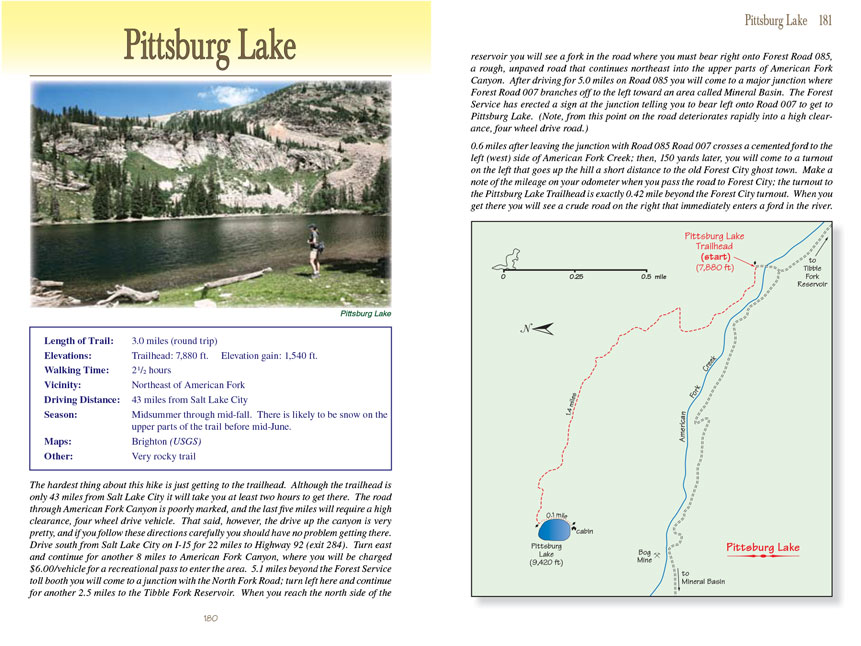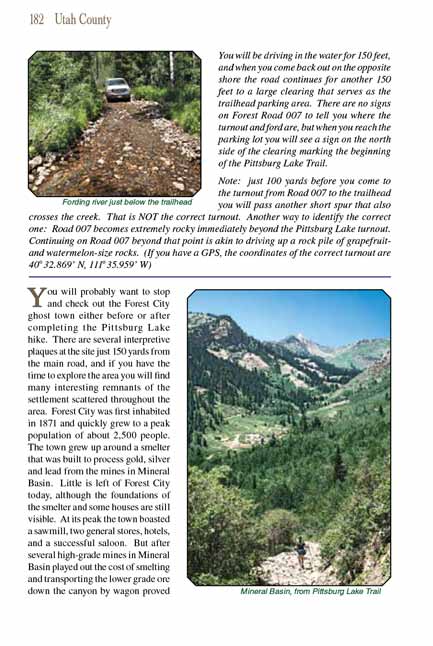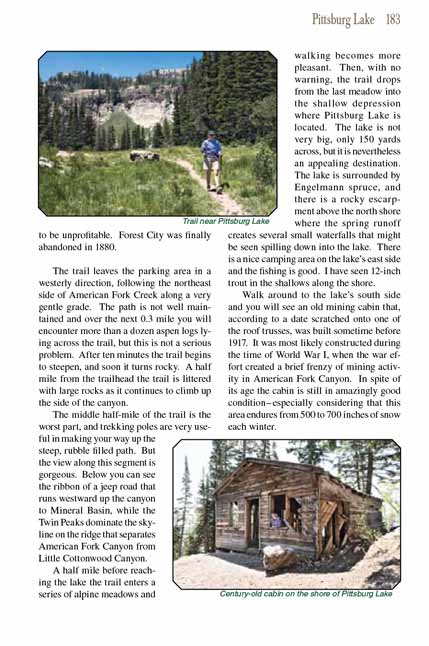Pittsburg Lake Trail
excerpted from our book
Salt Lake City's Incredible Hiking and Biking Trails
pages 180-183
|
Buy book directly from the author!
Salt Lake City's Incredible Hiking and Biking Trails
- has access info for 73 trailheads
- 73 colorful trail maps
- 325 full color photographs
- loads of hiking tips
|
regularly $19.95
now on sale for only
$9.95
click here
for book orders
|


 You will probably want to stop and check out the Forest City ghost town either before or after completing the Pittsburg
Lake hike. There are several interpretive plaques at the site just 150 yards from the main road, and if you have the time to explore the area you will
find many interesting remnants of the settlement scattered throughout the area. Forest City was first inhabited in 1871 and quickly grew to a peak
population of about 2,500 people. The town grew up around a smelter that was built to process gold, silver and lead from the mines in Mineral Basin.
Little is left of Forest City today, although the foundations of the smelter and some houses are still visible. At its peak the town boasted a
sawmill, two general stores, hotels, and a successful saloon. But after several high-grade mines in Mineral Basin played out the cost of smelting
and transporting the lower grade ore down the canyon by wagon proved to be unprofitable. Forest City was finally abandoned in 1880.
You will probably want to stop and check out the Forest City ghost town either before or after completing the Pittsburg
Lake hike. There are several interpretive plaques at the site just 150 yards from the main road, and if you have the time to explore the area you will
find many interesting remnants of the settlement scattered throughout the area. Forest City was first inhabited in 1871 and quickly grew to a peak
population of about 2,500 people. The town grew up around a smelter that was built to process gold, silver and lead from the mines in Mineral Basin.
Little is left of Forest City today, although the foundations of the smelter and some houses are still visible. At its peak the town boasted a
sawmill, two general stores, hotels, and a successful saloon. But after several high-grade mines in Mineral Basin played out the cost of smelting
and transporting the lower grade ore down the canyon by wagon proved to be unprofitable. Forest City was finally abandoned in 1880.
The Pittsburg Lake trail leaves the parking area in a westerly direction, following the northeast side of American Fork Creek along a very gentle grade. The path is
not well maintained and over the next 0.3 mile you will encounter more than a dozen aspen logs lying across the trail, but this is not a serious problem.
After ten minutes the trail begins to steepen, and soon it turns rocky. A half mile from the trailhead the
Pittsburg Lake trail is littered with large rocks as it
continues to climb up the side of the canyon.
The middle half-mile of the Pittsburg Lake trail is the worst part, and trekking poles are very useful in making your way up the steep, rubble filled path. But the view
along this segment is gorgeous. Below you can see the ribbon of a jeep road that runs westward up the canyon to Mineral Basin, while the Twin Peaks dominate
the skyline on the ridge that separates American Fork Canyon from Little Cottonwood Canyon.
A half mile before reaching Pittsburg Lake the trail enters a series of alpine meadows and walking becomes more pleasant. Then, with no warning, the trail drops
from the last meadow into the shallow depression where Pittsburg Lake is located. The lake is not very big, only 150 yards across, but it is nevertheless
an appealing destination. The lake is surrounded by Engelmann spruce, and there is a rocky escarpment above the north shore where the spring runoff
creates several small waterfalls that might be seen spilling down into the lake. There is a nice camping area on
Pittsburg Lake’s east side and the fishing
is good. I have seen 12-inch trout in the shallows along the shore.
Walk around to the Pittsburg Lake’s south side and you will see an old mining cabin that, according to a date scratched onto one of the roof trusses, was built
sometime before 1917. It was most likely constructed during the time of World War I, when the war effort created a brief frenzy of mining activity in
American Fork Canyon. In spite of its age the cabin is still in amazingly good condition-especially considering that this area endures from 500 to 700
inches of snow each winter.
Note to web developers: You may copy this material onto your site, but in return please include a link to my home page
www.utahtrails.com. Thank you, David Day (utahdavidday at gmail.com)
Click here to see more
trails near Salt Lake City
© Rincon Publishing Company, all rights reserved
|


 You will probably want to stop and check out the Forest City ghost town either before or after completing the Pittsburg
Lake hike. There are several interpretive plaques at the site just 150 yards from the main road, and if you have the time to explore the area you will
find many interesting remnants of the settlement scattered throughout the area. Forest City was first inhabited in 1871 and quickly grew to a peak
population of about 2,500 people. The town grew up around a smelter that was built to process gold, silver and lead from the mines in Mineral Basin.
Little is left of Forest City today, although the foundations of the smelter and some houses are still visible. At its peak the town boasted a
sawmill, two general stores, hotels, and a successful saloon. But after several high-grade mines in Mineral Basin played out the cost of smelting
and transporting the lower grade ore down the canyon by wagon proved to be unprofitable. Forest City was finally abandoned in 1880.
You will probably want to stop and check out the Forest City ghost town either before or after completing the Pittsburg
Lake hike. There are several interpretive plaques at the site just 150 yards from the main road, and if you have the time to explore the area you will
find many interesting remnants of the settlement scattered throughout the area. Forest City was first inhabited in 1871 and quickly grew to a peak
population of about 2,500 people. The town grew up around a smelter that was built to process gold, silver and lead from the mines in Mineral Basin.
Little is left of Forest City today, although the foundations of the smelter and some houses are still visible. At its peak the town boasted a
sawmill, two general stores, hotels, and a successful saloon. But after several high-grade mines in Mineral Basin played out the cost of smelting
and transporting the lower grade ore down the canyon by wagon proved to be unprofitable. Forest City was finally abandoned in 1880.